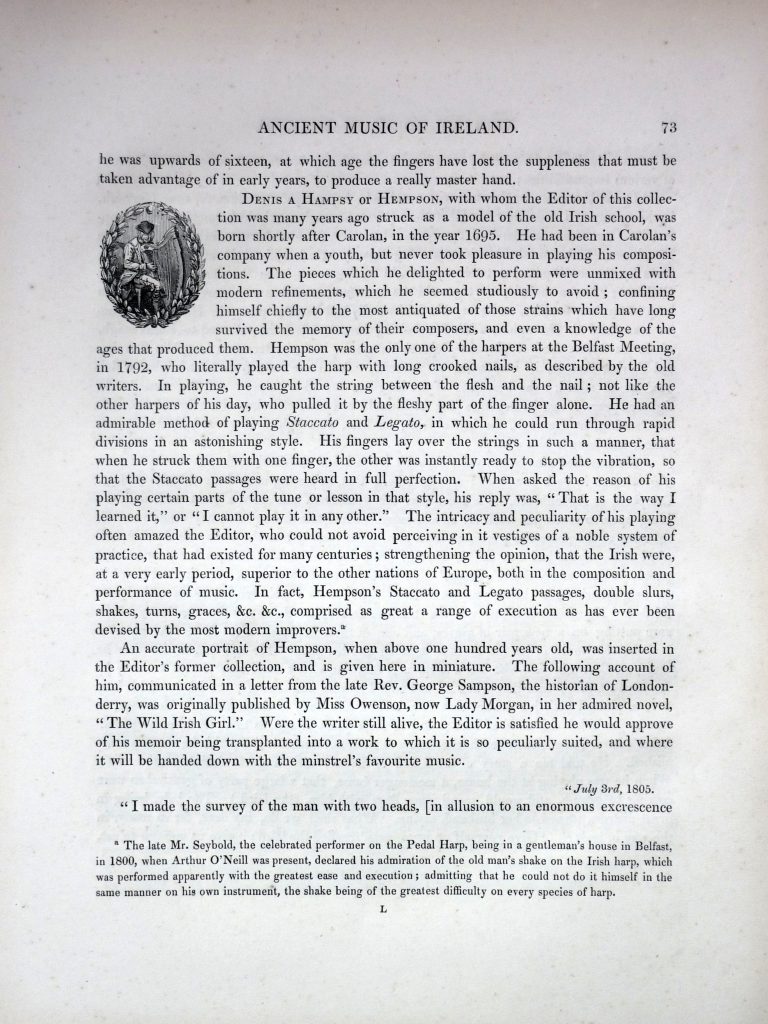Today I was working on tunes collected by Edward Bunting from the 18th century Irish harper, Arthur Ó Néill, for my concert in St Andrews on 3rd August.
As I played through some of his settings of Carolan and other baroque Irish harp music, using a copy of an 18th century Irish harp, I started thinking about the whole issue of playing the harp with long fingernails.
My Nails page on earlygaelicharp.info lists historical mention of the use of fingernails to play early Gaelic harp. Two passages are relevant here. The first, written in Latin as early as 1662, describes the decline of fingernail playing in general by the end of the 17th century:
Porro cytharistæ peritiores et cultiores humeris lyræ cervicem cernui ut plurimum, nonnunquam erecti admoventes, fila œnea extremis digitis, non unguibus pulsant contra consuetudinem ut, aliqui scribunt, lyristis non ita pridem in Hibernia familiarem, quæ nunc vel in desuetudinem abiit, vel a rudioribus lyristis frequentatur, contendentibus, editiorem sonitum e chordis ideo elicere, ut eo domus tota personet.
The more expert and accomplished performers (who generally bend over the neck of the harp, but occasionally hold it erect), strike the brass strings with the tips of their fingers, not with their nails, contrary to the custom, as some maintain, which not long since was common in Ireland. That custom is now, if not obsolete, at least adopted by ruder performers only, in their anxiety to elicit thereby louder notes from the strings, and make the whole house ring with their melody.
Gratianus Lucius, Cambrensis Eversus

The second quote is directly relevant to the question of Arthur Ó Néill’s repertory. Edward Bunting, writing in 1840 but describing his interviews with the old harpers in the 1790s, was very taken by the fingernail playing of Denis O’Hampsey. He contrasted Denis’s long fingernails with
…the other harpers of his day, who pulled it [the string] by the fleshy part of the finger alone
When I first acquired a replica 18th century Irish harp, I got a copy of the Downhill harp, so that I could use it to study the repertory and style of Denis O’Hampsey as attested in Edward Bunting’s manuscript notebooks from the 1790s. To play that music as collected from O’Hampsey, of course long nails are required.
However, my work to reconstruct Arthur Ó Néill’s repertory and style leads me in a different direction. In the past couple of years, I have helped the HHSI commission copies of much larger 18th century Irish harps, which reveal the petite and gracile nature of the Downhill harp, and which allow much more rich and deep bass-lines to be played.
But should I be using my long fingernails to play this repertory?
“No”, is the obvious answer.
The only problem is that I need my long fingernails to play my medieval repertory.
Fingernails seem to grow about 1mm a week, or slightly less. My nails are about 5mm long, so I would be thinking 5 or 6 weeks between cutting them completely short, and growing them fully back to their current length.
But perhaps I don’t need to be that extreme. Perhaps I could still play finger-tip style with nails 1mm long, and medieval-style with them 4mm long, which would mean 3 weeks wait.
My Arthur Ó Néill concert is on Wednesday 3rd August; I am presenting a participatory workshop on medieval music at Scoil na gCláirseach on Monday 22nd August, only 2½ weeks later.
Not sure what to do now!

I don’t think you have enough time to devolop callouses on your fingertips. I’ve cut my fingernails for going on long trips and tried playing out of curiosity and it’s pretty painful.
I cut my nails short today. I’ll post updates here on this blog on my progress re-learning how to play the harp. It is very different, but I think it will open up a new understanding of how the 18h century baroque Irish harp music works.
Spirits of camphor!!! Hardens the skin.
I wonder if the difference in string spacing between early and some later harps increases the possibilities for mixed nail/finger pad styles of playing?
I’m not sure what the downhill harp spacing is .